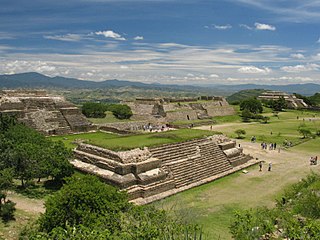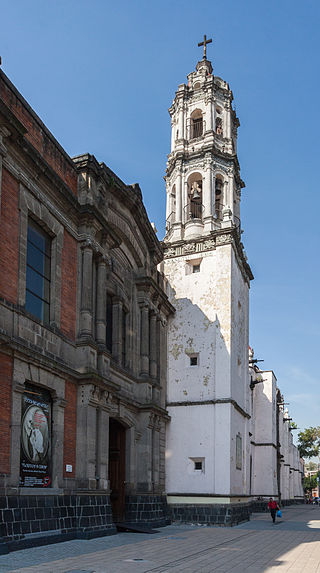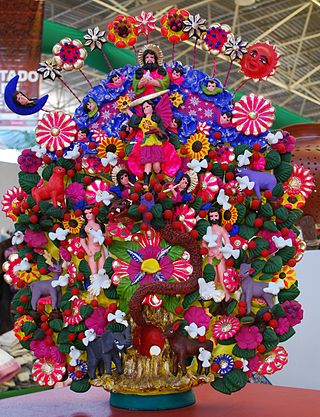| Fountain of Virgin | |
|---|---|
 The fountain in 2015 | |
 | |
| Location | Mexico City, Mexico |
| 19°26′8.7″N99°8′38.3″W / 19.435750°N 99.143972°W | |
The Fountain of Virgin is installed in Mexico City's Alameda Central, in Mexico.
| Fountain of Virgin | |
|---|---|
 The fountain in 2015 | |
 | |
| Location | Mexico City, Mexico |
| 19°26′8.7″N99°8′38.3″W / 19.435750°N 99.143972°W | |
The Fountain of Virgin is installed in Mexico City's Alameda Central, in Mexico.


Puebla de Zaragoza, formally Heroica Puebla de Zaragoza, formerly Puebla de los Ángeles during colonial times, or known simply as Puebla, is the seat of Puebla Municipality. It is the capital and largest city of the state of Puebla, and the fourth largest city in Mexico, after Mexico City, Monterrey, and Guadalajara. A viceregal era planned city, it is located in the southern part of Central Mexico on the main route between Mexico City and Mexico's main Atlantic port, Veracruz—about 100 km (62 mi) east southeast of Mexico City and about 220 km (140 mi) west of Veracruz.

Oaxaca de Juárez, or simply Oaxaca, is the capital and largest city of the eponymous Mexican state of Oaxaca. It is the municipal seat for the surrounding municipality of Oaxaca. It is in the Centro District in the Central Valleys region of the state, in the foothills of the Sierra Madre at the base of the Cerro del Fortín, extending to the banks of the Atoyac River.

The Trevi Fountain is an 18th-century fountain in the Trevi district in Rome, Italy, designed by Italian architect Nicola Salvi and completed by Giuseppe Pannini in 1762 and several others. Standing 26.3 metres (86 ft) high and 49.15 metres (161.3 ft) wide, it is the largest Baroque fountain in the city and one of the most famous fountains in the world.

Manuel Vicente Tolsá Sarrión was a prolific Neoclassical architect and sculptor in Spain and Mexico. He served as the first director of the Academy of San Carlos.

San Juan de los Lagos is a city and municipality located in the northeast corner of the state of Jalisco, Mexico, in a region known as Los Altos. It is best known as the home of a small image of the Virgin Mary called Our Lady of San Juan de los Lagos. Miracles have been ascribed to her since 1632 and have made the Basilica of San Juan de los Lagos a major tourist attraction. The economy of the city is still heavily dependent on the flow of pilgrims to the shrine, which has amounted to between seven and nine million visitors per year.

Alameda Central is a public urban park in downtown Mexico City. Created in 1592, the Alameda Central is the oldest public park in the Americas. It is located in Cuauhtémoc borough, adjacent to the Palacio de Bellas Artes, between Juárez Avenue and Hidalgo Avenue. Alameda Central can be accessed by Metro Bellas Artes.

Santo Domingo in Mexico City refers to the Church of Santo Domingo and its Plaza, also called Santo Domingo. Both are located three blocks north of the Mexico City Metropolitan Cathedral following República de Brasil Street with Belisario Dominguez Street separating the two.

The Santa Veracruz Monastery in the historic center of Mexico City is one of the oldest religious establishments in Mexico City and was the third most important church in the area in the 16th century. It was established by a religious brotherhood founded by Hernán Cortés.

Regina Coeli Convent Church is a Roman Catholic parish church and former convent built in the historic center of Mexico City, on the corner of Regina and Bolivar Streets.
Plaza México is a multi-purpose retail and cultural center in Lynwood, California. It includes shopping, including individual stores and an indoor swap meet; dining; and entertainment selections and is a cultural space for the Mexican-American community. Plaza México incorporates the design and style of plazas in Mexico. The mall was developed and is currently owned by Korean investors. It hosts cultural festivals and performances, such as "El Grito de la Independencia" and "Cinco de Mayo" festivities.

The pottery of Metepec is that of a municipality in central Mexico, located near Mexico City. It is noted for durable utilitarian items but more noted for its decorative and ritual items, especially sculptures called “trees of life,” decorative plaques in sun and moon shapes and mermaid like figures called Tlanchanas. Metepec potters such as the Soteno family have won national and international recognition for their work and the town hosts the annual Concurso Nacional de Alfarería y Cerámica.

Mixcoac is an area of southern Mexico City which used to be a separate town and municipality within the Mexican Federal District until it was made part of Mexico City proper in 1928.

The Huntress Diana Fountain is a monumental fountain of Diana located in the roundabout at Paseo de la Reforma and Río Misisipí and Sevilla streets, on the border of the Colonia Cuauhtémoc and Colonia Juárez neighborhoods of Mexico City. Nearby landmarks named after the fountain include the Cine Diana and the skyscrapers Corporativo Reforma Diana and Torre Diana.

The Fountain of Mercury is installed in Mexico City's Alameda Central, in Mexico. The fountain's statue depicts Mercury.

País de volcanes is an outdoor fountain and sculpture by the Spanish-born Mexican artist Vicente Rojo Almazán, installed outside Mexico City's Secretariat of Foreign Affairs Building and next to the Memory and Tolerance Museum, in Mexico. It is a 1,000 square meters (11,000 sq ft) artwork that features 1,034 ocher-colored pyramids standing out of the water; the artwork was made with tezontle, a type of reddish volcanic rock. The central body of the fountain contains water that flows subtly down its sides to the area with the pyramids. For Jaime Moreno Villarreal of Letras Libres, the fountain is located slightly below the square level so that the viewer can appreciate the volcanic geography.

Isaac is a statue by Epitacio Calvo.

Fuente de los Cántaros is an outdoor fountain and sculpture of an indigenous woman in Mexico City's Parque México, in Mexico, created by José María Hernández Urbina in 1927, and restored in 2008.

Plaza Tapatía is an urban plaza in Centro, Guadalajara, in the Mexican state of Jalisco. The plaza is made of multiple smaller squares, Paseo del Hospicio and the Central Esplanade.